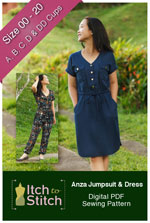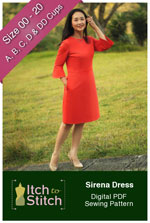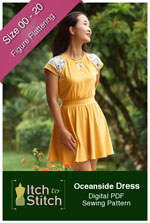digital fisterra top + dress sewing pattern
The Fisterra Top + Dress looks just as good with sneakers and a shopping tote as it does with kitten heels and a martini. The Fisterra comes in peplum top and midi dress options, and you can also choose to add pleated sleeve cuffs to the short sleeves.
-
Itch to Stitch Digital Patterns
This style is provided as a digital pattern. It may be printed on home printers that use either 8 1/2" x 11" or A4 paper or at a print shop that can print A0-sized pattern sheets. When you complete your order, you will be provided with a unique code to instantly download the pattern. See our digital product policy for full details.
All Itch to Stitch patterns come as multiple PDF files consolidated within a single .zip file. Download and save the .zip file to a computer to access the PDF files. Downloading .zip files to mobile devices is not recommended as most phones and tablets cannot open them.
Description
The Fisterra looks just as good with sneakers and a shopping tote as it does with kitten heels and a martini. The Fisterra comes in peplum top and midi dress options, and you can also choose to add pleated sleeve cuffs to the short sleeves.
Fisterra Top + Dress features:
- Options for cup sizes
- Options for peplum top and midi-dress
- Short sleeves with pleated sleeve caps
- Option to add pleated sleeve cuffs
- V neck finished with facings
- Relaxed bodice with elastic-shirred back waistband
- Lined bodice and skirt/peplum
- Shoulder seam moved forward as yoke seams
- Gathers at front yoke seam and waist
- No zipper
- Designed for lightweight woven fabric
Sizes: 00 – 40
Suggested Fabrics
Primary Fabric: Lightweight woven fabric with no stretch such as lightweight linen, chambray, lawn, crepe, shirting, and challis.
Lining: Very lightweight woven fabric with no stretch such as voile, batiste, and viscose/rayon lining fabric.
Interfacing: Lightweight fusible woven or weft insertion interfacing.
Notions
- One spool (11 yards/10 meters) of elastic thread
Size Chart, Finished Measurements, and Fabric Requirements
Click to enlarge the final images at above right.
Choosing Your Size
- Determine your cup size—subtract the circumference of your over bust from the circumference of the fullest part of your bust. If the rounded difference is 1″ (2.5 cm), use A cup; 2″ (5 cm), use B cup; 3″ (7.5 cm), use C cup; 4″ (10 cm), use D cup; 5″ (12.5 cm), use DD cup.
- After determining the cup size, compare your bust circumference (fullest part) to the “Body Measurements” table. Using the corresponding row for your cup, choose the size that best fits your bust. If you are between sizes, choose the smaller size if you like your garment more fitted; otherwise, choose the bigger size.
- Compare your waist circumference (narrowest part) to the “Body Measurements” table. Choose the size that best fits your waist. If you are between sizes, choose the smaller size if you like your garment more fitted; otherwise, choose the bigger size.
- Compare your hip circumference (widest part) to the “Body Measurements” table. Choose the size that fits your hip best. If you are between sizes, choose the smaller size if you like your garment more fitted; otherwise, choose the bigger size.
- It’s OK to use different sizes for the bust, waist and hip. The instructions for blending sizes are included in the pattern.
- If you are taller or shorter than 5’6” (168 cm), you should consider lengthening or shortening the garment. The instructions for lengthening or shortening are included in the pattern.
- It is highly recommended that you check your fit by making a test garment with inexpensive fabric that has similar weight as your final garment fabric.
-
Be the first to review this item.














